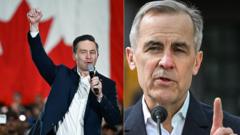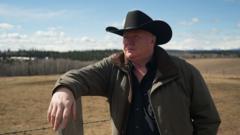With the Canadian election campaign drawing to a close, the dynamics between the Liberal and Conservative parties reveal deep voter frustrations and the pivotal impact of U.S. President Trump on Canadian politics, as the country prepares to vote on Monday.**
Canada’s Election Campaign: A Tug-of-War Between Trump and Trudeau’s Legacy**

Canada’s Election Campaign: A Tug-of-War Between Trump and Trudeau’s Legacy**
The latest updates from the 2025 Canadian election highlight the fierce competition between Liberal leader Mark Carney and Conservative leader Pierre Poilievre amidst the shadow of U.S. politics.**
At a fervent rally in London, Ontario, Liberal leader Mark Carney's warnings about the dangers posed by President Trump were met with spirited cries of defiance from the crowd, reflecting a deep-rooted Canadian pride. "President Trump is trying to break us so that America could own us," Carney declared, only to be heartily interrupted by chants of "Never!" from supporters brandishing Canadian flags on hockey sticks. In stark contrast, Conservative leader Pierre Poilievre has drawn substantial crowds by appealing to what he describes as a "Lost Liberal decade," a narrative he uses to rally supporters amid growing skepticism towards the sitting government.
On the brink of a crucial election day, polls indicate a close race for the lead, with national surveys showing the Liberals slightly ahead after a remarkable turnaround from earlier in the campaign. As tensions rise, Trump's influence cannot be ignored; analysts suggest that voters are primarily focused on which candidate has the clearest strategy to face the U.S. president's threats and tariffs. The Conservatives have pivoted their messaging from a broken system to a rallying cry of "Canada First," while simultaneously attempting to distance themselves from accusations of echoing Trumpist rhetoric.
In a campaign characterized by collective anxiety around issues like housing and social justice, many voters feel disillusioned. Take Barrie residents Eric and Carri Gionet, who express concern about their daughters’ future homeownership prospects—a sentiment echoed across demographics. Although a steady stream of voters has initially supported Poilievre, the political landscape shifted dramatically following the resignation of former Prime Minister Trudeau, paving the way for Carney's rise, who is leveraging his experience dealing with economic crises.
However, not all voters are convinced; some, like 69-year-old Gwendolyn Slover, express skepticism about whether Carney can enact substantive change. As the election approaches, the complex interplay of U.S.-Canada relations has forced both parties to confront the reality of economic dependence and potential turmoil stemming from Trump's policies.
As both frontrunners race towards the finish line, they share a common goal: to garner over 38% of the national vote, which has not been achieved since 1975. The ongoing campaign has also shed light on simmering regional tensions, overshadowing discussions on vital issues such as climate change and immigration.
In closing messages, Carney maintains that "It's time for experience, not experiments," while Poilievre urges for immediate change to reclaim Canadians' agency in shaping their futures. As the electorate remains divided yet passionate, Canada stands on the threshold of what could be a historic election amid a backdrop of U.S. influence and evolving national sentiment.



















